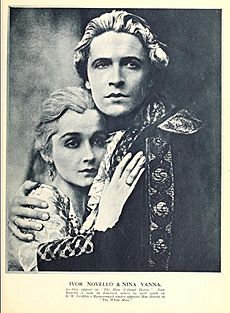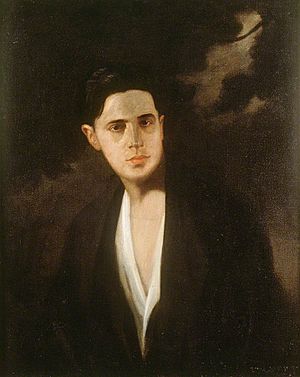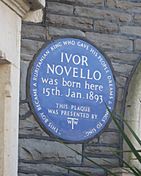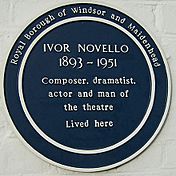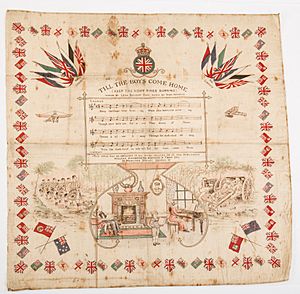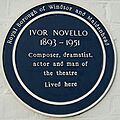Ivor Novello facts for kids
Ivor Novello (born David Ivor Davies; 15 January 1893 – 6 March 1951) was a talented Welsh actor, writer, singer, and composer. He became one of the most popular British entertainers in the first half of the 20th century.
Novello came from a musical family. His first big successes were as a songwriter. His song "Keep the Home Fires Burning" (1914) became very popular during the First World War. His show Theodore & Co in 1917 was also a hit during the war. After the war, Novello wrote songs for many successful musical comedies. He eventually started writing the music for entire shows. He created his musicals in the style of operetta, often working with writer Christopher Hassall.
In the 1920s, Novello began acting. He found great success in both British films and on stage. He starred in two silent films directed by Alfred Hitchcock: The Lodger and Downhill (both from 1927). On stage, he played the main character in the first London show of Liliom (1926). Novello briefly went to Hollywood but soon returned to Britain. Here, he had more success, especially on stage, with his own grand West End musical productions. His most famous musicals were Glamorous Night (1935) and The Dancing Years (1939).
From the 1930s, he often performed with actress Zena Dare, writing roles for her in his shows. He continued to write for films. However, later in his career, his biggest hits were his stage musicals. These included Perchance to Dream (1945), King's Rhapsody (1949), and Gay's the Word (1951).
The Ivor Novello Awards, which honor songwriters, were named after him in 1955.
Contents
Early Life and Musical Beginnings
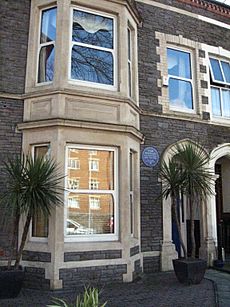
Ivor Novello was born David Ivor Davies in Cardiff, Wales. His father, David Davies, collected rent for the city council. His mother, Clara Novello Davies, was a famous singing teacher and choir conductor. As a boy, Novello was a successful singer in the Welsh Eisteddfod, a big festival of Welsh culture.
His mother later became a voice teacher in London. There, young Ivor met many famous performers. These included people from the Gaiety Theatre and classical musicians. One of his mother's friends, Clara Butt, even taught him to sing when he was just six years old.
Novello went to private schools in Cardiff and Gloucester. In Gloucester, he studied music with Herbert Brewer, who was a cathedral organist. He then won a scholarship to Magdalen College School in Oxford. There, he was a solo singer in the college choir. He later said that hearing a lot of old sacred music made him prefer grand, romantic music.
Even though his teacher thought he wouldn't have a music career, Novello was good at writing songs from a young age. One of his songs was published when he was only 15. After school, he taught piano in Cardiff. In 1913, he moved to London with his mother. They lived in a flat above the Strand Theatre, which became his home for the rest of his life.
In London, he met Sir Edward Marsh, who supported artists. Marsh encouraged Novello to compose music and introduced him to people who could help his career. Ivor started using his mother's middle name, "Novello," as his professional last name. He didn't legally change it until 1927.
In 1914, when the First World War began, Novello wrote "Keep the Home Fires Burning." This song captured the feelings of many families separated by the war. Novello wrote the music for the song, and an American writer named Lena Guilbert Ford wrote the words. It became a huge hit, bringing Novello fame and money at just 21 years old. Novello joined the Royal Naval Air Service in 1916. He later moved to an office role at the Admiralty in London for the rest of the war.
Becoming a Composer and Actor
Novello kept writing songs while serving in the Royal Naval Air Service. He had his first stage success with Theodore & Co in 1916. This show was produced by George Grossmith Jr. and Edward Laurillard, with music by Novello and Jerome Kern. That same year, Novello also wrote for a show called See-Saw. In 1917, he added songs to an existing French musical called Arlette.
Novello continued to write successful music for shows and revues after the war. These included Who's Hooper? (1919) and The Golden Moth (1921), for which Novello wrote all the music. He also contributed songs to revues like A to Z (1921). One of his well-known comedy songs from this time was "And Her Mother Came Too."
While succeeding as a composer, Novello also started a career as an actor. He had a "classic profile" that made him a popular star in films. A Swiss film director, Louis Mercanton, saw a photo of him and offered him a role in a silent film called The Call of the Blood (1920). He made another film for Mercanton that year, and his first British film, Carnival, the next year.
Novello first acted on stage in 1921 in a play called Deburau. He also played a role in a charity show of Pride and Prejudice.
In 1923, Novello made his first American movie, The White Rose, directed by D. W. Griffith. That same year, he starred in The Man Without Desire and other British films. Next, he helped write, produce, and star in the popular 1924 play The Rat. This play was made into a film in 1925, which was so successful that two more movies followed in 1926 and 1928. On the West End stage, he played the main character in the first London production of Liliom (1926).
Other films Novello starred in include Alfred Hitchcock's The Lodger and Downhill (both in 1927). A British film company offered Novello a great contract. This allowed him to buy a country house called 'Redroofs' near Maidenhead. He was known for hosting many famous parties there. In the late 1920s, Novello was the most popular male British film star. He was often called Britain's "handsomest screen actor."
Novello returned to composing for the stage in 1929. He wrote songs for a show called The House that Jack Built. That same year, he presented his own play Symphony in Two Flats, which he took to New York. This was followed by a successful Broadway show of his play The Truth Game. This caught the attention of Hollywood studios. He signed a contract to write for and appear in MGM films. However, he didn't find much to do in Hollywood, besides writing dialogue for Tarzan the Ape Man. He returned to London and starred in the sound remake of The Lodger (1932).
Hit Musicals of the 1930s
After starting the 1930s with several non-musical plays, Novello returned to composing in 1935 with Glamorous Night. This was the first of many very popular musicals. Many people remember Novello best for these shows.
For all his four musicals in the 1930s, Novello wrote the story and the music. Christopher Hassall wrote the song lyrics. Glamorous Night starred Novello and Mary Ellis, along with Zena Dare and Olive Gilbert. It ran for a long time, from May 1935 to July 1936.
Careless Rapture ran for 296 shows, starring Novello, Dorothy Dickson, and Zena Dare. Crest of the Wave also starred Novello and Dickson, running for 203 shows. Novello's last musical before the war was The Dancing Years. It starred Novello, Ellis, and Gilbert. It opened in London, closed when the Second World War started, then toured, and reopened. It ran for a total of 696 performances. In this show, Novello played an Austrian composer and conductor.
Later Years and Legacy
Novello created only two new shows during the Second World War. Arc de Triomphe (1943) was a musical for Mary Ellis, but it was only a small success. However, Perchance to Dream (1945) was a huge hit, running for 1,022 performances.
Novello's last big musical in his famous style was King's Rhapsody (1949). This show was a romantic escape from the difficulties of war. It featured crown princes, ballrooms, and beautiful princesses. It was very popular and ran for 841 performances. Novello starred in the show, along with Phyllis Dare, Zena Dare, and Olive Gilbert.
While King's Rhapsody was still playing, Novello's very last show opened. This was Gay's the Word (1951). Novello did not act in this show. It starred the comedy actress Cicely Courtneidge. This show was different from his usual style, mixing European operetta with newer American musicals. Critics noted that the show even made fun of the romantic stories that had brought him so much success.
Death and Lasting Impact
Ivor Novello died suddenly at age 58 from a heart attack. This happened just a few hours after he finished a performance of King's Rhapsody. He was cremated at the Golders Green Crematorium. His ashes are buried under a lilac bush with a plaque that says, "Ivor Novello 6th March 1951 'Till you are home once more'."
A famous writer, Noël Coward, wrote about Novello shortly before his death. He said that theater was Novello's greatest love. Coward noted that "whenever and wherever he appears the vast majority of the British public flock to see him." The Grove Dictionary of Music and Musicians calls Novello "the 20th century's most consistently successful composer of British musicals" before Andrew Lloyd Webber.
The Ivor Novello Awards were created in 1955 to honor him. These awards are given every year to British songwriters and composers. A scholarship was also set up in his memory at the Royal Academy of Dramatic Art. In 1952, a bronze statue of him was placed at Drury Lane theatre. A special panel was installed to remember Novello in St. Paul's, Covent Garden, known as the 'actors' church'. In 1972, a memorial stone was unveiled in St. Paul's Cathedral.
In 1993, many shows celebrated the 100th anniversary of Novello's birth. In 2005, the Strand Theatre, where Novello lived for many years, was renamed the Novello Theatre. A plaque honoring him was placed at the entrance. On June 27, 2009, a statue of Novello was unveiled outside the Wales Millennium Centre in Cardiff Bay. The statue's base has plaques listing some of his most famous songs.
Novello was played by Jeremy Northam in the 2001 film Gosford Park. Several of his songs were used in the movie, including "Waltz of My Heart" and "I Can Give You the Starlight." Jeremy Irvine played Novello in the 2021 film Benediction.
Famous Songs by Ivor Novello
Ivor Novello wrote many well-known songs. Some of his most famous include:
- "Keep the Home Fires Burning"
- "Fold Your Wings"
- "Shine Through My Dreams"
- "Rose of England"
- "I Can Give You the Starlight"
- "And Her Mother Came Too"
- "My Dearest Dear"
- "The Land of Might-Have-Been"
- "When I Curtsied to the King"
- "We'll Gather Lilacs"
- "Someday My Heart Will Awake"
- "Yesterday"
- "Waltz of My Heart"
- "Why Isn't It You"
- "My Life Belongs to You"
- "Fly Home Little Heart"
- "Take Your Girl"
- "Primrose"
While Novello's music is often thought of as romantic, it was actually very varied. He wrote romantic hits like "Someday My Heart Will Awake." But he also wrote exciting operetta songs and upbeat jazz numbers. "Rose of England" is a grand patriotic song that can be compared to works by famous composers like Edward Elgar or William Walton.
Ivor Novello's Film Roles
Novello was a popular actor in many films. Here are some of the movies he starred in:
| Year | Title | Role | Country |
|---|---|---|---|
| 1920 | Miarka: The Daughter of the Bear | Ivor | France |
| 1921 | The Call of the Blood | Maurice Delarey | |
| Carnival | Count Andrea Scipione | United Kingdom | |
| 1922 | The Bohemian Girl | Thaddeus | |
| 1923 | The White Rose | Joseph Beaugarde | United States |
| Bonnie Prince Charlie | Prince Charles Stuart | United Kingdom | |
| The Man Without Desire | Count Vittorio Dandolo | Germany / United Kingdom | |
| 1925 | The Rat | Pierre Boucheron, 'the Rat' | United Kingdom |
| 1926 | The Triumph of the Rat | ||
| 1927 | The Lodger | The Lodger | |
| Downhill | Roddy Berwick | ||
| 1928 | The Constant Nymph | Lewis Dodd | |
| The Vortex | Nicky Lancaster | ||
| A South Sea Bubble | Vernon Winslow | ||
| The Gallant Hussar | Lieutenant Stephen Alrik | Germany / United Kingdom | |
| 1929 | The Return of the Rat | Pierre Boucheron, 'the Rat' | United Kingdom |
| 1930 | Symphony in Two Flats | David Kennard | |
| 1931 | Once a Lady | Bennett Cloud | United States |
| 1932 | The Lodger | Michel Angeloff/"The Bosnian Murderer" | United Kingdom |
| 1933 | I Lived with You | Prince Felix Lenieff | |
| Sleeping Car | Gaston | ||
| 1934 | Autumn Crocus | Andreas Steiner |
Ivor Novello's Writing Credits
Novello also wrote for many films. Here are some of the movies he wrote for:
| Year | Title | Country |
|---|---|---|
| 1925 | The Rat | United Kingdom |
| 1926 | The Triumph of the Rat | |
| 1927 | Downhill | |
| 1929 | The Return of the Rat | |
| 1930 | Symphony in Two Flats | |
| 1932 | Tarzan the Ape Man | United States |
| But the Flesh Is Weak | ||
| The Lodger | United Kingdom | |
| 1933 | I Lived with You | |
| 1937 | Glamorous Night | |
| The Rat | ||
| 1941 | Free and Easy | United States |
| 1950 | The Dancing Years | United Kingdom |
| 1955 | King's Rhapsody |
Images for kids
-
Sculpture of Novello at Cardiff Bay
See also
 In Spanish: Ivor Novello para niños
In Spanish: Ivor Novello para niños




